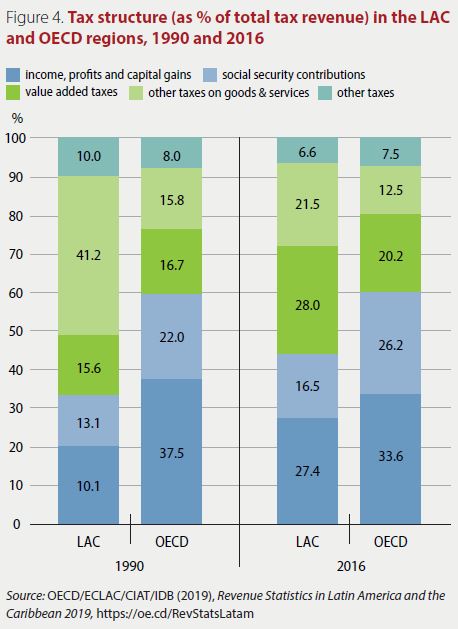Revenue Statistics in Latin America and the Caribbean 2019
The Organisation for Economic Co-operation and Development (OECD) has released its latest revenue statistics report for Latin America and the Caribbean. The report compiles comparable tax revenue statistics over the period 1990-2017 for 25 Latin American and Caribbean (LAC) economies. Based on the OECD Revenue Statistics database, it applies the OECD methodology to countries in Latin America and the Caribbean to enable comparison of tax levels and tax structures on a consistent basis, both among the economies of the region and with other economies.
Highlights
The average tax-to-GDP ratio in Latin America and the Caribbean rose to 22.8% in 2017, a gain of 0.2 percentage points from 2016. The average remained 11.4 percentage points below the OECD average (34.2% of GDP in 2017), but the difference between the two regions has declined from 16.4 percentage points in 1990.
- Uneven performance: The increase in the unweighted average tax-to-GDP ratio in the LAC region in 2017 reversed a year-on-year decline of 0.1 percent points in 2016 and reflected an overall recovery in the regional economy. However, the year-on-year change was uneven across the region: while tax revenues increased as a proportion of GDP in 12 countries, they declined in 10 and remained unchanged in two. Moreover, tax-to-GDP ratios across the LAC region vary significantly, ranging from 12.4% in Guatemala to 40.6% in Cuba.
- VAT reliance, declining CIT revenues & increasing PIT revenues: The LAC region continues to rely on taxes on goods and services, with value-added taxes alone accounting for 27.9% of total tax revenues on average in 2017, equivalent to 6.0% of GDP. Over the past decade, corporate income tax (CIT) revenues have declined as a percentage of GDP whereas revenues from personal income tax (PIT) have steadily increased, respectively reaching 3.4% and 2.2% of GDP on average in 2017.
- Closing the gap: While CIT revenues remain higher than the OECD average (2.9% of GDP), PIT revenues are still well below the OECD average (8.2% of GDP). Overall, the average tax structure in LAC has evolved to be closer to the average OECD structure, thanks to an increase in revenues from income taxes and value-added tax (VAT) and a decline in revenues from taxes on trade.
- Green taxes: Environmentally related taxes are an emerging source of revenues in a number of LAC countries. Across the 22 countries for which data are available, revenues from this source averaged 1.1% of GDP, versus an OECD average of 1.6%. In recent years, Chile, Mexico and Colombia have introduced significant green tax reforms.
Special features
The report contains two special features. The first identifies trends in fiscal revenues from non-renewable natural resources, for a selection of countries in the LAC region in 2017 and 2018. The second examines recurrent taxes on immovable property in Latin America.
(Source: News release | Read the report | Brochure)
Fiscal Panorama of Latin America and the Caribbean 2019: Tax policies for resource mobilization in the framework of the 2030 Agenda for Sustainable Development
The United Nations Economic Commission for Latin America and the Caribbean (ECLAC) has published Fiscal Panorama of Latin America and the Caribbean 2019: Tax policies for resource mobilization in the framework of the 2030 Agenda for Sustainable Development.
Fiscal Panorama of Latin America and the Caribbean, 2019 examines the role of tax policy as a tool for driving progress towards achievement of the Sustainable Development Goals. One way to strengthen collection is to address the challenges of taxing the rapidly growing digital economy. Tax policy can also be used to shift production and consumption patterns to encourage decarbonization of the economy and support improvements in public health. Lastly, the document analyses the constraints on domestic resource mobilization caused by fiscal incentives and how, effectively geared towards investment, these incentives could instead foster sustainable and inclusive development.
Highlights
Fiscal consolidation continued in Latin America and the Caribbean in 2018. The fiscal position in Latin America improved, reflecting cuts in primary spending, mainly through capital expenditures. Despite this adjustment, gross public debt is trending upward in Latin America with rises occurring in several countries. Conversely, the Caribbean countries continue to generate primary surpluses —driven, in 2018, by higher public revenues— and have thus succeeded in reducing their gross public debt levels, which nevertheless remain high.
(Source: ECLAC | Read the report)




Recent Comments